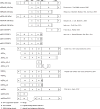Crosstalk between nuclear and G protein-coupled estrogen receptors
- PMID: 28450143
- PMCID: PMC5656538
- DOI: 10.1016/j.ygcen.2017.04.013
Crosstalk between nuclear and G protein-coupled estrogen receptors
Abstract
In 2005, two groups independently discovered that the G protein-coupled receptor GPR30 binds estradiol in cultured cells and, in response, initiates intracellular signaling cascades Revankar et al. (2005), Thomas et al. (2005). GPR30 is now referred to as GPER, the G-protein coupled estrogen receptor Prossnitz and Arterburn (2015). While studies in animal models are illuminating GPER function, there is controversy as to whether GPER acts as an autonomous estrogen receptor in vivo, or whether GPER interacts with nuclear estrogen receptor signaling pathways in response to estrogens. Here, we review the evidence that GPER acts as an autonomous estrogen receptor in vivo and discuss experimental approaches to test this hypothesis directly. We propose that the degree to which GPER influences nuclear estrogen receptor signaling likely depends on cell type, developmental stage and pathology.
Copyright © 2017 Elsevier Inc. All rights reserved.
Figures


Similar articles
-
Role of GPER-Mediated Signaling in Testicular Functions and Tumorigenesis.Cells. 2020 Sep 17;9(9):2115. doi: 10.3390/cells9092115. Cells. 2020. PMID: 32957524 Free PMC article. Review.
-
Estrogen signaling through the G protein-coupled estrogen receptor regulates granulocyte activation in fish.J Immunol. 2013 Nov 1;191(9):4628-39. doi: 10.4049/jimmunol.1301613. Epub 2013 Sep 23. J Immunol. 2013. PMID: 24062489
-
Role of G-protein-coupled estrogen receptor (GPER/GPR30) in maintenance of meiotic arrest in fish oocytes.J Steroid Biochem Mol Biol. 2017 Mar;167:153-161. doi: 10.1016/j.jsbmb.2016.12.005. Epub 2016 Dec 19. J Steroid Biochem Mol Biol. 2017. PMID: 28007532 Review.
-
A transmembrane intracellular estrogen receptor mediates rapid cell signaling.Science. 2005 Mar 11;307(5715):1625-30. doi: 10.1126/science.1106943. Epub 2005 Feb 10. Science. 2005. PMID: 15705806
-
Estrogen biology: new insights into GPER function and clinical opportunities.Mol Cell Endocrinol. 2014 May 25;389(1-2):71-83. doi: 10.1016/j.mce.2014.02.002. Epub 2014 Feb 12. Mol Cell Endocrinol. 2014. PMID: 24530924 Free PMC article. Review.
Cited by
-
G Protein-Coupled Estrogen Receptor (GPER) and ERs Are Modulated in the Testis-Epididymal Complex in the Normal and Cryptorchid Dog.Vet Sci. 2024 Jan 5;11(1):21. doi: 10.3390/vetsci11010021. Vet Sci. 2024. PMID: 38250927 Free PMC article.
-
Deciphering of a Putative GPER Recognition Domain in ERα and ERα36.Front Endocrinol (Lausanne). 2022 Jun 30;13:943343. doi: 10.3389/fendo.2022.943343. eCollection 2022. Front Endocrinol (Lausanne). 2022. PMID: 35846328 Free PMC article. No abstract available.
-
G-Protein-Coupled Estrogen Receptor-1 Positively Regulates the Growth Plate Chondrocyte Proliferation in Female Pubertal Mice.Front Cell Dev Biol. 2021 Aug 20;9:710664. doi: 10.3389/fcell.2021.710664. eCollection 2021. Front Cell Dev Biol. 2021. PMID: 34490260 Free PMC article.
-
Sex Differences in Colon Cancer: Genomic and Nongenomic Signalling of Oestrogen.Genes (Basel). 2023 Dec 16;14(12):2225. doi: 10.3390/genes14122225. Genes (Basel). 2023. PMID: 38137047 Free PMC article. Review.
-
Supplementation of 17β-Estradiol Normalizes Rapid Gastric Emptying by Restoring Impaired Nrf2 and nNOS Function in Obesity-Induced Diabetic Ovariectomized Mice.Antioxidants (Basel). 2020 Jul 3;9(7):582. doi: 10.3390/antiox9070582. Antioxidants (Basel). 2020. PMID: 32635208 Free PMC article.
References
-
- Acconcia F, Ascenzi P, Fabozzi G, Visca P, Marino M. S-palmitoylation modulates human estrogen receptor-alpha functions. Biochemical and biophysical research communications. 2004;316:878–883. - PubMed
-
- Albanito L, Madeo A, Lappano R, Vivacqua A, Rago V, Carpino A, et al. G Protein-Coupled Receptor 30 (GPR30) Mediates Gene Expression Changes and Growth Response to 17β-Estradiol and Selective GPR30 Ligand G-1 in Ovarian Cancer Cells. Cancer Research. 2007;67:1859–1866. - PubMed
-
- Balhuizen A, Kumar R, Amisten S, Lundquist I, Salehi A. Activation of G protein-coupled receptor 30 modulates hormone secretion and counteracts cytokine-induced apoptosis in pancreatic islets of female mice. Molecular and cellular endocrinology. 2010;320:16–24. - PubMed
-
- Bologa CG, Revankar CM, Young SM, Edwards BS, Arterburn JB, Kiselyov AS, et al. Virtual and biomolecular screening converge on a selective agonist for GPR30. Nat Chem Biol. 2006;2:207–212. - PubMed
Publication types
MeSH terms
Substances
Grants and funding
LinkOut - more resources
Full Text Sources
Other Literature Sources

